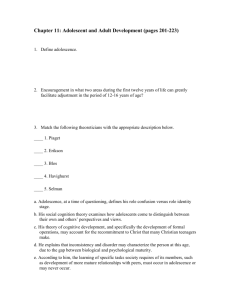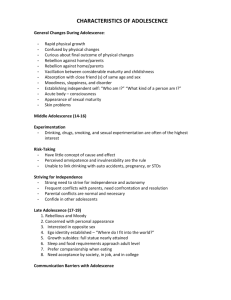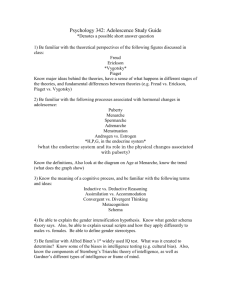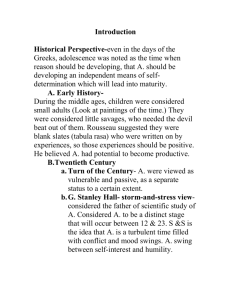Developmental Psychology Research Paper
advertisement
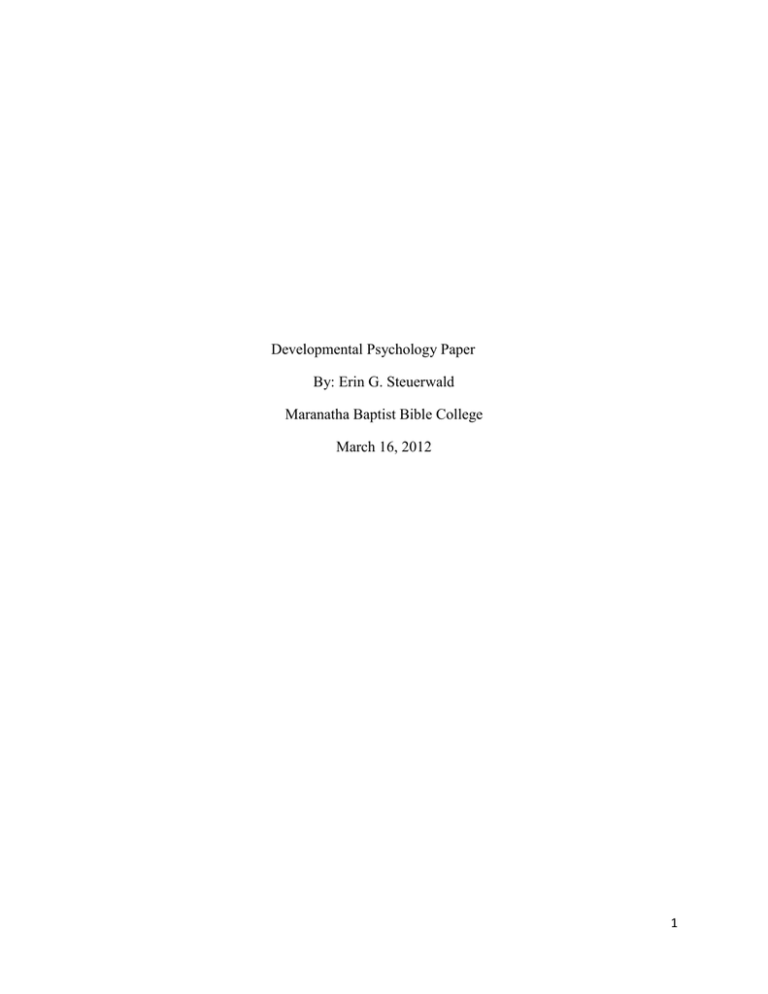
Developmental Psychology Paper By: Erin G. Steuerwald Maranatha Baptist Bible College March 16, 2012 1 Physical Development (adolescent) Research Topic: Obesity Obesity can be defined as an abnormal accumulation of body fat, usually 20% or more of an individual’s ideal weight. Body mass index (BMI) is used to help determine if a child is overweight or obese. While BMI does not measure body fat directly, it is calculated by using one’s age, gender, weight and height and is usually a reasonable indicator of body fat. According to the Center of Disease and Control, obesity can be defined as a BMI at or about the 95th percentile for children the same age and sex (CDC, n.d.). Despite having an understanding of what obesity is, the United States continues to see huge increases in obesity among its youth. The growth of obesity among United States adolescents aged 12-19 has jumped from just 5% in 1980 to 18% in 2008 with obesity still on the incline. It is most prevalent in the Southeast, with the highest percentages among African American girls (29.2%) and Mexican-American boys (26.7%) (Ogden et al., 2010). There are many factors that contribute to obesity among adolescence including unhealthy eating habits and lack of exercise. The diet of youth in the last few decades has changed dramatically to include high caloric snacks, soft drinks, fried foods, and high-fat meats. These, with the combination of fast-food convenience and “super-size” options, has led to substantial opportunities to overeat. Not only are youth overeating, but they are not getting the exercise they once did due to an increase in TV and computer time. According to one study about 60% of teenagers spend an average of 20 hours of screen time per week, while about a third of teens spend closer to 40 hours (American Heart, 2008). These factors, along with the influence of genetics, medications, and stressful life events, all contribute to the high obesity rate. The consequences of obesity can continue with a teen into their adult years. These risks include an increased threat of heart disease, high blood pressure, diabetes, depression, as well as 2 breathing and sleeping problems. Since studies have revealed that children who are obese between the ages of 10 and 13 are 80% likely to be obese as adults, it is critical that we inform adolescence of the consequence of obesity and help them establish healthy behaviors. Application: The reason we have P.E. and Health teachers is to prevent obesity among our youth. This can be prevented by providing active, stimulating activities, as well as emphasizing the importance of a healthy diet and lifestyle. The activities that I present in class should be safe, developmentally appropriate activates that engage both the mind and body. They should be games of inclusion that keep kids active despite their ability level. As a health teacher, it is critical that I inform students of healthy food choices, portion sizes, and the consequences of poor eating habits. Mr. John Steuerwald has been teaching teenagers for over twenty years and has seen the affects that unhealthy nutritional habits can have on behaviors in the classroom. Kids are consuming too much pop, candy, and other junk foods as snacks. He has noticed that many students’ lunches consist of processed meals high in sodium, sugar, and fats. These foods low in nutrition causes their minds to race to the point that they can’t concentrate or think clearly. They can become overly hyper or exhibit the opposite effect of becoming tired and sluggish (Steuerwald, 3-15-12). Poor nutrition in combination with a lack of exercise can easily lead to poor behavior in the classroom as well as weight problems. 3 Social Development (adolescent) Research topic: Cooperation and competition Cooperative and competitive are a vibrant part of adolescents. Boys typically thrive for competitive environments, while girls typically prefer cooperative activities. But before we decide which is best in an educational setting, it is essential that we understand what is meant by each. Competition can be defined as, “a social process that occurs when rewards are given to people on the basis of how their performances compare with the performances of others doing the same task or participating on the same event” (Weinberg & Gould, 2007). This means that when one participant or group out performs others they are rewarded and automatically causes the failure of others. Cooperation, on the other hand, can be defined as, “a social process through which performance is evaluated and rewarded in terms of the collective achievements of a group of people working together to reach a particular goal” (Weinberg & Gould, 2007). Cooperation is characterized by mutual involvement of all participants, in which rewards are shared equally, and success depending solely on the collective achievements of all in the group. Now that we have defined what cooperation and competition is, let’s look at some of the positives and negatives of each. Competition is a positive means to improve and refine skills. An important advantage of competition is that it constantly gives one feedback. With competition, you have a way to measure how well or how poorly you are doing, what skills you are doing right, and which ones need improvement. Competition can also teach discipline, perseverance, boost self-esteem, and help young people develop good work ethics. Although competition is inherently neither good nor bad, it can lead to peer comparisons, excessive aggression and an over emphasis on winning. One study revealed that competitors were, “self-centered, directed their efforts at beating others, 4 had closed communication, and exhibited group conflict and mistrust” (Weinberg & Gould, 2007). The same study revealed that cooperative students, “communicated openly, shared information, developed friendships, and actually solved more puzzles than their competitive counterparts” (Weinberg & Gould, 2007). In a cooperative environment, success is defined through individual progress and values effort rather than ability. Young people learn to share and work together towards their goals. One of the draw backs of competition is that some students can easily “fall through the cracks” and let others do the work while they sit back and watch. It is key that all students do their part while participating in cooperative activities. It is essential that educators incorporate a combination of cooperative and competitive elements into their classrooms. Application: As a physical educator it is essential that I provide an environment that promotes skill development and fair play. This can be done by providing instructional feedback and encouragement regardless of the competitions outcome. Mr. Steuerwald creates an environment of competition and cooperation by designing games that focus on working together to improve by beating a previous record or time. For example they will play a game and record the time or number of questions that were answered correctly. The next day when this drill is run, if the class beats the previous record, they get to erase the board and record the new one. This allows students to work cooperatively, yet compete against the previous day’s score (Steuerwald, 3-13-12). 5 Emotional Development (adolescence) Research Topic: Stress Stress can be defined as, “a substantial imbalance between demand (physical and/or psychological) and response capability, under conditions where failure to meet that demand has important consequences” (Weingberg & Gould, 2008). It is a very real problem among adolescence and can come from a variety of sources. The main stressors for adolescence come from school demands, community pressure, and relationship problems with friends and family. School stressors may stem from participation in to many activities, difficulty grasping certain subjects, or setting too high expectations. Teens may experience stress from community pressure to participate in drugs, smoking, or alcohol. Family stressors can include moving and switching schools, divorce, and family financial problems; while friend stressors can include breakups, rejections, and lack of acceptance. Now that we know a few of the stressor that teens deal with, it is important to understand how boys and girls differ in how they handle stress. According to one study on Baltimore teens, boys often tried to reduce stress by avoidance and seeking out other distractions, while girls typically looked for support. Girls were also found to experience more stress than boys, stemming largely from their relationships with boys as well as friends. Boys, on the other hand, attributed their stress to authority figures such as teachers or parents (Teen help, 2011). Since there are many different stresses and ways they are handled, it is important to realize the uniqueness of each situation and develop ways to cope with stress. Application: As a teacher, there are many ways to help young people reduce stress. One way is to help kids plan and organize a task. Instead of focusing on a large task, help them break it up into smaller more attainable tasks. Then, help young people set goals for when they want to see 6 each component accomplished. Another way teachers can help reduces stress is by allowing time for rehearsal and practice. When you have prepared well, and have practiced the stressful event in a similar situation, you will feel more confident and in control when the actual event comes around. Another important way I can help kids reduce stress is by allowing them to take breaks. Usually we view breaks in school as recesses or lunch, but changing subjects as well as art and P.E. classes are routine events that allow for a change of pace. In fact, drawing, exercising and doing other recreational hobbies are all ways we can reduces stress. As a P.E. teacher, I want to remember that my classes may be an essential time when kids can reduce stress through exercise. It is should be an enjoyable experience, in a safe and fun environment, where they can get their mind off their everyday stressors. Mr. Steuerwald sees stress affect performance in his classroom as students struggle to concentrate as their mind wonders to some other concern. He seeks to reduce stress in the classroom by allowing breaks and helping students manage large projects. One example of stress that he notices is when students won’t answer questions because of a fear of getting them wrong or looking dumb in front of their friends. He tries to eliminate this stress by asking certain students that struggle easier question, allowing student to come up with an answer with a neighbor, or simply working with a response and making it right (Steuerwald, 3-15-12). 7 Moral Development (adolescence) Research Topic: Kohlberg’s Stages Moral development involves knowing the differences between what is right and wrong. Moral development is marked by changes in thoughts, feelings, and behaviors as a child grows older. One of the best known theories on the subject was developed by Lawrence Kohlberg who modified and expanded the two-stage process of moral development by Jean Piaget. Kohlberg extended Piaget’s theory by proposing that moral development is a continual process throughout one’s life and developed a three level, six stage model. Most Adolescence fall into level two or the conventional level of moral reasoning. This is where they begin to apply certain standards which are set by others such as parents or government to everyday life (Santrock, 2008). The conventional level often judges the morality of actions by comparing them to society’s views and expectation. At this level, young people will obey rules and follow norms even when there is no consequence for obedience or disobedience. Whether or not a rule is appropriate or fair is seldom questioned. Within this level, most adolescence are considered to be in stage three or the interpersonal accord and conformity driven stage. This stage is often connected to “good boy-good girl” orientation because adolescence often seek the approval of their parents or society by taking on their moral standards (Santrock, 2008). In this stage, there is an emphasis on conformity, being “nice,” and consideration of how choices influence relationships. Some adolescence in their late teens may have moved beyond stage three and the need for approval and began to show signs of stage four or social systems morality. At this stage, moral judgments are made on the basis of the importance of obeying laws and rules to maintain a functioning society. They often reason that 8 they must adhere to laws in order for a community to work effectively. While late teens may show signs of stage four, young adolescence may still possess characteristics of stage two or the individualism and exchange stage. This stage is characterized by a “what’s in it for me” mentality. Individuals pursue their own interests and show limited interest in others. Overall, while most adolescence possess the characteristics of stage three, some may still show signs of stage two or four as well. Application: What stuck out to me most is that in stage three, adolescence are especially concerned with approval from others. They want to be viewed as “nice” and are willing to conform to standards of society around them. They will do just about anything to be liked, so it is important that we as teachers realize the peer pressure going on and do are part to warn of its dangers. For example, as a health teacher, it is my responsibility to teach my students the dangers of alcohol and drug abuse. These are things that adolescences may try as a means to gain acceptance, but are obviously are not good for their health. Stage three of Kohlberg’s theory is characterized by wanting acceptance by conforming to the standards of others. Mr. Steuerwald has seen this take place in classrooms over the years as kids will seek to do the latest “cool” things to fit in such as bleaching hair, wearing a certain style of jeans, or playing certain games. Peer pressure is strong in the teenage years and must be recognized and warned about. 9 Spiritual Development(adolescence) Research Topic: Spiritual Growth The teenage years are characterized by insecurities and many feel vulnerable in just about everything. They worry about issues such as their appearance and body, understanding life and the future, and their personality (Tripp, 1995). While this is a period of instability, anxiety, and vulnerability, it is also a time when young people seek to become their own person. Often this leads to rebellion when authority figures attempt to corral him. It is during these years, as the child begins to envision living on his own without his parents, when rebellion begins to be expressed. This should not take adults by surprise because in reality, this rebellion has been dormant for years. Now that we understand some of the insecurities and rebellion characteristic of teens, it is important to establish how to encourage and guide them in spiritual growth. Teens can continue to grow spiritually by making sure they establishing three foundations found in Proverbs 1:7-10: the fear of the Lord, adherence to parental instruction, and disassociation from the wicked (Tripp, 1995). The first foundation is found in Proverbs 1:7 where it says, “The fear of the Lord is the beginning of knowledge, but fools despise wisdom and instruction” (KJV). Living in the fear of the Lord means living in the realization of accountability to Him (Tripp, 1995). It is living with a respect for God, knowing that He sees everything, and seeking to worship Him. It is not a question of if a teen will worship, but what he will worship. Will they give in to seeking the approval of men and peer pressure, or will they live out of a fear of God instead. Not only do teens need to establish the foundation of the fear of the Lord to combat insecurities, but they also must learn to listen to wise biblical instruction. This principle can be 10 found in Proverbs 1:8-9 which says, “My son, hear the instruction of thy father, and forsake not the law of thy mother: For they shall be an ornament of grace unto thy head, and chains about thy neck” (KJV). Teens will be enriched and will greatly benefit by the adherence to the values and instructions of wise adults. The young person who adheres to wise instruction will be blessed! The third foundation that can lead a teen towards spiritual growth is a disassociation from the wicked found in Proverbs 1:10, “My son, if sinners entice thee, consent thou not” (KJV). The importance of establishing good friendships is critical. A teen must learn to establish friendships with others who will encourage her spiritually. Application: As teachers, it is important that we seek to find ways in which we can establish each of these key foundational principles into our classrooms. We can help teens disassociate from the wicked by placing them in a good environment. As teachers, we don’t have a choice necessarily of what students we have, but we can affect the environment by showing care and compassion for each individual. Teens will be less apt to run with the wrong crowd when they are loved, accepted, and have solid relationships in their lives. We can also help young people develop a fear of the Lord and see the importance of wise instruction by sharing personal examples with them, as well as biblical examples. It should be something that is talked about in the classroom when appropriate to do so. Mr. Steuerwald seeks to create a spiritual environment in his classroom by making it a priority, and seeking to reward spiritual decisions more than academics or sports. He emphasizes the importance of living by example, and seeks to foster a spiritual atmosphere by incorporating daily Bible lessons, devotional times, and prayer (Steuerwald, 3-15-12). 11 Cognitive Development(adolescence) Research Topic: Piaget’s Stages Most adolescence fit into Piaget’s fourth stage of cognitive development called the formal operational stage seen around the ages of eleven to fifteen year olds. In this stage, adolescence reason in more abstract, idealistic, and logical ways. In this formal operational stage, this abstract quality can be seen in their ability to verbally solve problems and their tendency to think about thought itself (Santrock, 2008). They can begin to understand abstract concepts such as love or trust as well. Idealism in adolescence is characterized by speculation of ideal characteristics. As they look for characteristics they desire for themselves and others, they begin to compare themselves with others. This can lead to fantasizing about future possibilities. The logical quality of adolescence thought is characterized by problem solving through trial-and-error. As a scientist, they begin to devise plans to solve problems and systematically test solutions using hypothetical-deductive reasoning. Many of Piaget’s ideas have been challenged over the years, believing there to be more individual variations than what he had originally thought. In fact, it is believed that only one in three young adolescents are formal operational thinkers, with even many adults yet to reach this stage (Santrock, 2008). One of those who added to his theory was David Elkind. He believed that adolescence’s social matters are governed by their egocentrism, or self-consciousness. This egocentrism comes from adolescence believing in an imaginary audience, which involves attention getting, and personal fables or the belief of one’s uniqueness and invincibility. Application: Although there may be problems with Piaget’s theory, some of his characteristics can be found in the classroom. For example, fantasy is definitely a characteristic of this age 12 group. Kids can fantasize about becoming a professional athlete and millionaire or through other objects such as reading books. Fantasy is not always a bad thing because it can be a way to relax or build dreams. The problem occurs when the teen can’t discern between fantasy and real life. This is when you as a teacher can help bring them back to reality. This does not mean that you need to shatter their dreams, but simply remind them of the hard work, effort, or commitment that it takes to reach a dream. As a teacher, you can help them set realistic goals that they can handle. Mr. Steurwald has seen fantasy in adolescence over the years. Some have struggled with an inflated view of themselves and their abilities while other come from a completely different perspective and have imaginary friends. He tries to direct both students back to truth and reality and encourages them in the right direction (Steuerwald, 3-15-12). 13 Bibliography American Heart Association (2008, March 12). Many Teens Spend 30 Hours A Week On 'Screen Time' During High School. Retrieval April 28, 2012, from http://www.sciencedaily.com/releases/2008/03/080312172614.htm CDC. (2011, 16 5). Cdc:centers for disease control and prevention. Retrieved from http://www.cdc.gov/obesity/causes/index.html Holy Bible (King James Version). Korea: Holman Bible Publishers. Ogden, Gynthia L.; Carroll, Margaret D.; Curtin, Lester R.; Lamb, Molly M.; Flegal, Katherine M. (2010). Prevalence of High Body Mass Index in U.S. Children and Adolescents, 2007-2008. Journal of the American Medical Association 303(3): 242-249. Santrock, J. W. (2008). A Topical Approach to: Life-Span Development (4th ed.). New York: McGraw-Hill. Steuerwald, John. Over twenty years of experience. 10th-12th grade teacher at Utica Christian School, Utica, WI. Date of interview: 3/15/12. TeenHelp.com. (2011). Teenhelp. Retrieved from http://www.teenhelp.com/teen-stress/stressstatistics.html Tripp, T. (1995). Shepherding a Child’s Heart. Pennsylvania: Shepherd Press. Weinberg, R. S., & Gould, D. (2008). Foundations of Sport and Exercise Psychology (4th ed.). Illinois: Human Kinetics. 14

